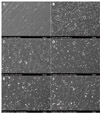1. Niinomi M. Metallic biomaterials. J Artif Organs. 2008; 11:105–110.
2. Grössner-Schreiber B, Griepentrog M, Haustein I, Müller WD, Lange KP, Briedigkeit H, Göbel UB. Plaque formation on surface modified dental implants. An in vitro study. Clin Oral Implants Res. 2001; 12:543–551.
3. Watzak G, Zechner W, Ulm C, Tangl S, Tepper G, Watzek G. Histologic and histomorphometric analysis of three types of dental implants following 18 months of occlusal loading: a preliminary study in baboons. Clin Oral Implants Res. 2005; 16:408–416.
4. Isidor F. Influence of forces on peri-implant bone. Clin Oral Implants Res. 2006; 17:8–18.
5. Becker W, Becker BE, Newman MG, Nyman S. Clinical and microbiologic findings that may contribute to dental implant failure. Int J Oral Maxillofac Implants. 1990; 5:31–38.
6. Jung CW. Peri-implant disease and GBR. 1st ed. Seoul: Narae publishing;2001. p. 2–7.
7. Elias CN, Figueira DC, Rios PR. Influence of the coating material on the loosing of dental implant abutment screw joints. Mater Sci Eng C. 2006; 26:1361–1366.
8. Chou WJ, Yu GP, Huang JH. Corrosion resistance of ZrN films on AISI 304 stainless steel substrate. Surf Coat Technol. 2003; 167:59–67.
9. Moon BH, Choe HC, Brantley WA. Surface characteristics of TiN/ZrN coated nanotubular structure on the Ti-35Ta-xHf alloy for bio-implant applications. Appl Surf Sci. 2012; 258:2088–2092.
10. Damaschek R, Strydom IL, Bergmann H. Improved adhesion of TiN deposited on prenitrided steels. Surf Eng. 1997; 13:128–132.
11. Groessner-Schreiber B, Neubert A, Müller WD, Hopp M, Griepentrog M, Lange KP. Fibroblast growth on surfacemodified dental implants: an in vitro study. J Biomed Mater Res A. 2003; 64:591–599.
12. Chollet L, Perry AJ. The stress in ion-plated HfN and TiN coatings. Thin Solid Films. 1985; 123:223–234.
13. Jeong YH, Kwag DM, Chung CH, Kim WG, Choe HC. Corrosion characteristics and surface morphologies of TiN and ZrN film on the abutment screw by Arc-ion coating(2). Corrosion Sci Technol. 2011; 10:212–217.
14. Nakazato G, Tsuchiya H, Sato M, Yamauchi M. In vivo plaque formation on implant materials. Int J Oral Maxillofac Implants. 1989; 4:321–326.
15. Mombelli A, Lang NP. Microbial aspects of implant dentistry. Periodontol 2000. 1994; 4:74–80.
16. Tai CN, Koh ES, Akari K. Macroparticles on TiN films prepared by the arc ion plating process. Surf Coat Technol. 1990; 43/44:324–335.
17. Quirynen M, van der Mei HC, Bollen CM, Schotte A, Marechal M, Doornbusch GI, Naert I, Busscher HJ, van Steenberghe D. An in vivo study of the influence of the surface roughness of implants on the microbiology of supraand subgingival plaque. J Dent Res. 1993; 72:1304–1309.
18. Lin NM, Huang XB, Zou JJ, Zhang XY, Qin L, Fan AL, Tang B. Effects of plasma nitriding and multiple arc ion plating TiN coating on bacterial adhesion of commercial pure titanium via in vitro investigations. Surf Coat Technol. 2012; 209:212–215.
19. Bollen CM, Lambrechts P, Quirynen M. Comparison of surface roughness of oral hard materials to the threshold surface roughness for bacterial plaque retention: a review of the literature. Dent Mater. 1997; 13:258–269.
20. Ryan V, Hart TR, Schiller R. Size determination of Streptococcus mutans 10499 by laser light scattering. Biophys J. 1980; 31:313–324.
21. Jeyachandran YL, Narayandass SK, Mangalaraj D, Bao CY, Martin PJ. The effect of surface composition of titanium films on bacterial adhesion. Biomed Mater. 2006; 1:L1–L5.
22. Jeyachandran YL, Venkatachalam S, Karunagaran B, Narayandass SK, Mangalaraj D, Bao CY, Zhang CL. Bacterial adhesion studies on titanium, titanium nitride and modified hydroxyapatite thin films. Mater Sci Eng C. 2007; 27:35–41.
23. Yoshinari M, Oda Y, Kato T, Okuda K. Influence of surface modifications to titanium on antibacterial activity in vitro. Biomaterials. 2001; 22:2043–2048.
24. Ata-Ali J, Candel-Marti ME, Flichy-Fernández AJ, Peñarrocha-Oltra D, Balaguer-Martinez JF, Peñarrocha Diago M. Peri-implantitis: associated microbiota and treatment. Med Oral Patol Oral Cir Bucal. 2011; 16:e937–e943.
25. Anselme K. Osteoblast adhesion on biomaterials. Biomaterials. 2000; 21:667–681.
26. Schwartz Z, Lohmann CH, Vocke AK, Sylvia VL, Cochran DL, Dean DD, Boyan BD. Osteoblast response to titanium surface roughness and 1alpha,25-(OH)(2)D(3) is mediated through the mitogen-activated protein kinase (MAPK) pathway. J Biomed Mater Res. 2001; 56:417–426.
27. Anselme K. Osteoblast adhesion on biomaterials. Biomaterials. 2000; 21:667–681.
28. Roach HI. Why does bone matrix contain non-collagenous proteins? The possible roles of osteocalcin, osteonectin, osteopontin and bone sialoprotein in bone mineralisation and resorption. Cell Biol Int. 1994; 18:617–628.
29. zur Nieden NI, Kempka G, Ahr HJ. In vitro differentiation of embryonic stem cells into mineralized osteoblasts. Differentiation. 2003; 71:18–27.





 PDF
PDF ePub
ePub Citation
Citation Print
Print







 XML Download
XML Download